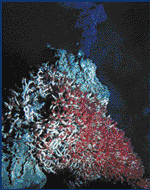Brent D. Johnson, Senior News Editor
In vents in the seafloor of the Juan de Fuca Ridge off the coast of British Columbia and Washington state, a community of organisms thrives amid a seething cauldron of superheated chemicals at temperatures and pressures inhospitable to terrestrial life. Hyperthermophiles, microbial organisms that prefer temperatures above 80 °C, thrive in these systems.
The problem with investigating these vents is finding a probe that can withstand their enormous pressures and temperature. Only thermocouples, H2, pH and sulfide electrochemical probes have been used successfully. Most studies have been based on samples collected by remotely operated vehicles and three-person submersibles with robotic arms. These vehicles carry samples to the surface for further study onboard ships or in the laboratory.
Ideally, one could insert a probe directly into a vent for continuous analysis at depth and a less biased view of what is happening. One reason for such study would be to monitor the minute geometrically complex pores inside the vents where the organisms are believed to grow.
Karl Booksh, a professor at Arizona State University, is an analytical chemist who has developed probes for industrial process monitoring in applications such as power plant reactors. During a conversation with colleague John Holloway, he recognized that these deep-sea vents are the "ultimate reactor."
Holloway was intrigued by the interactions between seawater and geochemistry at the vents. He said that the vents may affect global chemical cycles.
Hot and corrosive
A technique called surface plasmon resonance can use optical fiber probes to track changes in refractive index, such as when studying antibody-antigen binding by adsorbing proteins to a probe surface. A similar method could allow microbes to adhere to seafloor probes to provide information about which species are present.
One of the biggest technical problems is that vents, at depths where pressures exceed 200 atmos, spew water-based solutions rich in hydrogen sulfide at temperatures up to 400 °C.
"They dissolve almost anything, especially silica glass," Holloway said. Therefore, conventional optical fibers are not useful in such an environment. However, sapphire (aluminum oxide) is one of the least soluble materials in this environment.

Sapphire optical fibers could soon be used to monitor hydrothermal seafloor systems whose superheated chemical soup dissolves traditional silica glass probes.
Saphikon Inc. makes a sapphire fiber that may make it possible to develop surface plasmon resonance sensors. Louis Obando, who has made probes in Booksh's lab as part of his doctoral work, said it's much easier to work with glass fibers, but sapphire's durability, strength and imperviousness to chemical environments make the sapphire fibers a necessity. The fibers transmit over the 0.25- to 3.5-µm range and can be used at temperatures up to 2000 °C.
Obando said sapphire is not ideal for surface plasmon resonance because its refractive index is so high. The ideal substrate for a surface plasmon resonance sensor would be within 0.1 index units of the medium under study. Silica's refractive index is around 1.42, but sapphire's is 1.74, which makes seawaterlike solutions around 1.35 difficult to monitor. However, tapering the end of the fiber extends its dynamic range.
Obando and his colleagues hope to make a sapphire probe that can sense density changes in ocean systems. One application would be to track salinity changes and monitor the mineral flows around vents.
For their first trial of the resonance probes, Booksh and Holloway know the perfect place to explore: the Juan de Fuca Ridge